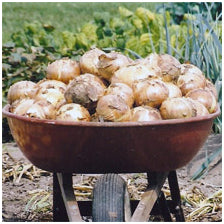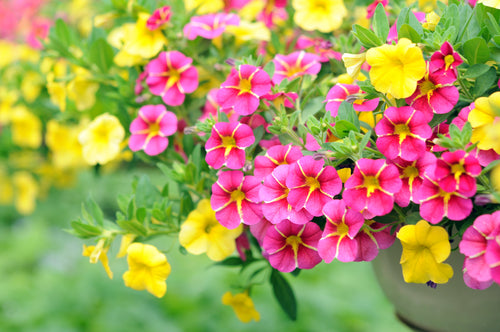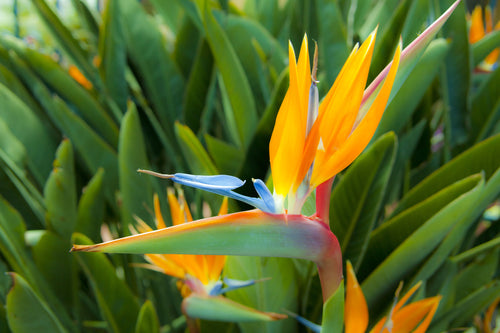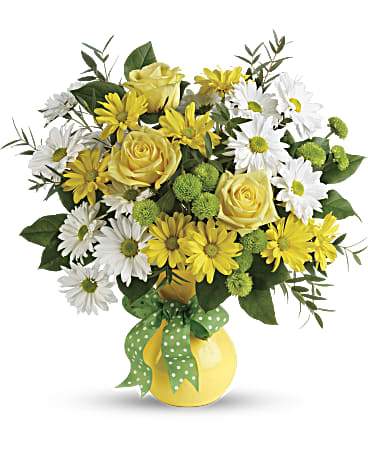Onions need direct sunlight. Place them in a full sun area of your garden.
Make sure to amend your soil before planting with Back to Nature Natures Blend Compost. Use 1 bag per 100 sq. ft. Cultivate a bag of coarse sand into the area. Rake the soil even then apply Dr. Earth Blood Meal and Dr. Earth Bulb Food at the rate of 2 cups per 10 ft. row along to the surface of the onion bed. Chop these organic fertilizers into the top 4 inches of soil with a rake. Dutch red, yellow and white dried onion sets (dried bulbs) are often used for scallions or green onions. Plant them 4 inches deep, 2 inches apart with the rows 12 inches apart. You can start to pick scallions when the tops are 12 inches tall.
Dried onion bundles of White Spanish, Yellow Spanish, Candy and Walla Walla are used to grow large onions but can also be used for scallions. Here’s the trick for large onions. Plant them only 1 inch deep, 4 inches apart with the rows 1 foot apart (see the above left photo). This may look strange as the onion continues to grow. Resist the temptation to push the onions deeper. As the onions grow larger they will appear to be almost sitting on top of the soil. This is okay! In 4 weeks mix 1 tablespoon of Dr. Earth Bulb Food lightly in the soil around each bulb. When the ground starts to crack as the onions push the soil away, the bulbing process has begun (as the onion reaches maturity). Stop fertilizing then (about three weeks before harvest).
Water your onion patch after planting. Onions have shallow root systems so they require frequent furrow irrigation. Water only the soil, not the foliage. Keep the soil evenly moist. If the onion’s foliage has an unhealthy, yellowish tint, the soil is over watered. Cracked soil is a sign of under watering. Onions require at least 30 inches of irrigation per growing season.
Keep the soil cultivated so the bulbs can easily expand in size. Use caution not to damage the bulbs. Severe insect problems can be controlled with Bonide’s Tomato & Vegetable.
When the onion tops turn yellow and fall over, it’s time to stop watering. They’re ready for harvest. Do not try to speed this process up by bending them over since this will decrease the bulb size.
Pull up your onions and spread them across the soil to dry in the sun for 2 days. Trim off the roots and cut the tops off to one inch.
Place in an onion mesh bag or nylon stocking and hang them up in a cool, dry place.
Now that the works done its time to day dream about fresh dug scallions with a dash of salt, grilled Maxwell Street polish sausage smothered in grilled onions, a slice of raw onion on a thick burger, French onion soup and homemade onion rings.
Mmm – Mmm ! Let’s Get Growing
Walla Walla
- Yellow, semi-flat, sweet, open pollinated
- Size Potential: Up to 6"
- Storage Potential: Approximately 1 month
- Days to Harvest: 90
Walla Walla has been a customer favorite for years and the pride of Washington State.
Candy
- Yellow, globe shaped, sweet, hybrid
- Size Potential: Up to 6"
- Storage Potential: Approximately 3 months
- Days to Harvest: 90
The most popular variety we offer. Grows almost everywhere in the country as a large mild onion that keeps well. This onion is great for beginner gardeners!
Yellow Sweet Spanish
- Yellow, globe shaped, mild, open pollinated
- Storage Potential: 4 months
- Days to Harvest: 100
Customer favorite! This is the favorite onion grown by commercial growers in northern states because it makes uniformly large, sweet bulbs. Grows great in intermediate day areas as well. Will mature slightly later than the Walla Walla so you can stagger your harvest.
Nutritional Value of Onion
Given below is the amount of nutrients in a medium–sized onion (approximately 150 grams):
- Vitamin A – 75 IU
- Vitamin C – 9 mg
- Calcium – 48 mg
- Proteins – 1 gm
- Phosphorus – 66 mg
- Carbohydrate – 16 gm
- Sodium – 5 mg
- Potassium – 200 mg
- Dietary Fiber – 3 gm
- Calories – 60
- Total Fat – 0 gm
- Saturated Fat – 0 gm












